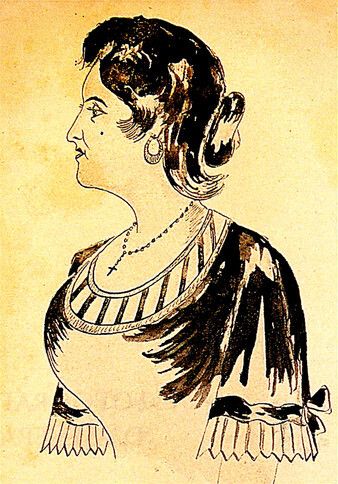Its history
remains to be written; however, some people took the first steps in the musical
genre, among them Maria Severa.
Maria
Severa Onofriana was born on 26 July 1820, in Madragoa, Lisbon, later staying
in the Mouraria area. Little is known about this woman who enchanted the
Portuguese in the 19th century, at a time of political tension, when the
Portuguese absolutist monarchy was at an end, giving way to a constitutional
monarchy.
The
memories that are known are the result of reports left by artists of the time,
who, having crossed paths with Maria Severa, felt the need to immortalise her.
According to the poet Bulhão Pato, Severa was “a very interesting Fado singer”,
even mentioning that in Mouraria there would never be a Fado singer like her
again. According to the poet, the young Fado singer was as generous as she was
outrageous and had no problem in caring for those she liked, as she could be
seconds later in the face of a violent brawl, where she defended herself and
those she liked. She was physically described by everyone as “slender”, and as
a tall woman with a piercing gaze.
Unknown
origins
Little is
known about her origins either. She has always been portrayed as the daughter
of a gipsy father, however, as time goes on, new clues have emerged. Público
newspaper recently published an article in which it reported that Maria Severa
may have had African origins, with her ancestors having been brought to
Portugal in the 17th century.
However,
the voice has always been the most mythologized feature of this woman. A warm
voice, full of hurt and pain, combined with Severa's sensuality, did not allow men
to approach her. Her strong voice and jerky movements suggested that Severa
just wanted to be heard and not touched. Little is also known where the young
Fado singer sang, it is speculated that she was in prostitution circuits, in
Bairro Alto and Mouraria, however, Maria Severa also performed for some
aristocrats.

In the
newspapers of the time, there are reports of Maria Severa's performances at the
Palácio do Conde, as well as the singer's romantic relationship with the Count
of Vimioso, whom she eventually met while singing at the Rosaria dos Óculos
tavern, on Rua do Capelão. The love relationship with D. Francisco de Paula
Portugal e Castro brought even more visibility to the singer who echoed her
voice in the streets of Lisbon while playing her guitar.
An early
death
Maria
Severa Onofriana died at the age of 26, an early death, leaving no record of
her voice. Some say that Severa, as she became known, was the founder of Fado
as it is known today. Her story was immortalised by Júlio Dantas who, in 1931,
had the work adapted for cinema, in what was the first Portuguese sound film.
In 1990, the work of Júlio Dantas was adapted to the theatre, with Lena Coelho,
former singer of Doce, playing Severa. The acclaimed Fado singer Amália
Rodrigues, in 1955, represented Severa in a musical, a play staged by the
company of Vasco Morgado.
In
Mouraria, on Rua do Capelão, is Largo da Severa, where the Fado singer used to
live, there is an old house which is marked “Casa da Severa” and, on the floor
the shape of a guitar is represented in the calçada.
Deeply in love with music and with a guilty pleasure in criminal cases, Bruno G. Santos decided to study Journalism and Communication, hoping to combine both passions into writing. The journalist is also a passionate traveller who likes to write about other cultures and discover the various hidden gems from Portugal and the world. Press card: 8463.











